

Youtube. Grimfrost Academy - Viking Religion. Youtube. Youtube. Youtube. Youtube. Skyrim- Viking Longhouse. Youtube. Vikings. The Vikings were diverse Scandinavian seafarers from Norway, Sweden, and Denmark whose raids and subsequent settlements significantly impacted the cultures of Europe and were felt as far as the Mediterranean regions c. 790 - c. 1100 CE.
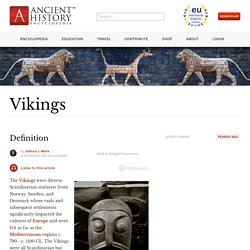
The Vikings were all Scandinavian but not all Scandinavians were Vikings. The term Viking applied only to those who took to the sea for the purpose of acquiring wealth by raiding in other lands, and the word was primarily used by the English writers, not inclusively by other cultures. Most Scandinavians were not Vikings, and those who traded with other cultures were known as Northmen, Norsemen, or other terms designating their origin. Viking. Sea-faring Danes depicted invading England.

Illuminated illustration from the 12th century Miscellany on the Life of St. Edmund. Pierpont Morgan Library. "The Wrath of the Northmen": The Vikings and their Memory. "The Wrath of the Northmen": The Vikings and their Memory by Christina von Nolckenou won't be surprised that the Vikings were normally viewed by those they came up against in a markedly negative light.
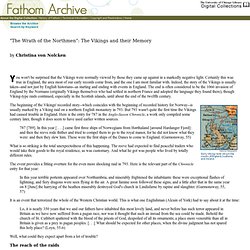
Certainly this was true in England, the area most of our early records come from, and the one I am most familiar with. Indeed, the story of the Vikings is usually taken--and not just by English historians--as starting and ending with events in England. The end is often considered to be the 1066 invasion of England by the Normans (originally Vikings themselves who had settled in northern France and adopted the language they found there), though Viking-type raids continued, especially in the Scottish islands, until about the end of the twelfth century. The beginning of the Vikings' recorded story--which coincides with the beginning of recorded history for Norway--is usually marked by a Viking raid on a northern English monastery in 793. 787 [789]. VIKINGS: INSIDE THE LIFE OF A VIKING - History/Discovery/Ancient (documentary) Norse Mythology 5 Gods of Asgard. The Vikings Video - Vikings. The Viking Village.
Viking Village - Construction. The Vikings: Voyage to America. Unity 5 Demo Scene: Viking Village. Vikings as Traders (article) When the Vikings left their homelands in the beginning of the Viking Age in the 790s, they didn’t just go to raid and loot.
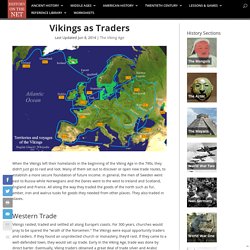
Many of them set out to discover or open new trade routes, to establish a more secure foundation of future income. In general, the men of Sweden went east to Russia while Norwegians and the Danes went to the west to Ireland and Scotland, England and France. All along the way they traded the goods of the north such as fur, amber, iron and walrus tusks for goods they needed from other places. Norse History Includes Violence, Democracy (article) Ravagers, despoilers, pagans, heathens — such epithets pretty well summed up the Vikings for those who lived in the British Isles during medieval times.
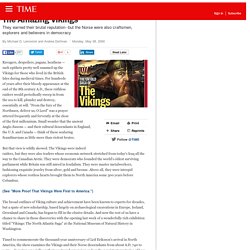
For hundreds of years after their bloody appearance at the end of the 8th century A.D., these ruthless raiders would periodically sweep in from the sea to kill, plunder and destroy, essentially at will. "From the fury of the Northmen, deliver us, O Lord" was a prayer uttered frequently and fervently at the close of the first millennium. Small wonder that the ancient Anglo-Saxons — and their cultural descendants in England, the U.S. and Canada — think of these seafaring Scandinavians as little more than violent brutes. But that view is wildly skewed. The Vikings were indeed raiders, but they were also traders whose economic network stretched from today's Iraq all the way to the Canadian Arctic.
Viking Explorers (interactive map) The Vikings came from lands around the coast of Scandinavia, areas we now know as Norway, Denmark, and Sweden.

Viking settlers built homes and farms in the lands they discovered. Viking settlements sprang up along seashores and river banks from central Europe all the way to North America. Vikings settled in Iceland around 870. Two settlements were made in Greenland around 986. The Vikings and the Viking Era (article) The Vikings and the Viking Era The era known as the Viking age lasted for more than 300 years, from the late 8th century to the late 11th century.
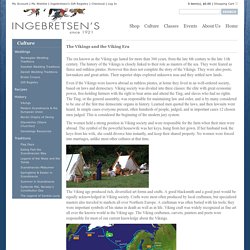
The history of the Vikings is closely linked to their role as masters of the sea. They were feared as fierce and ruthless pirates. Why Did the Vikings Pillage? (article) Scandinavians were certainly not the only people of their era to raid and pillage their neighbors, but they did it with greater frequency and a brutal efficiency not seen in other cultures.
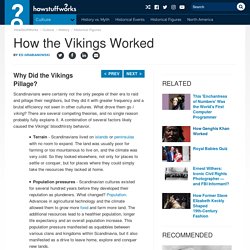
What drove them go i viking? There are several competing theories, and no single reason probably fully explains it. A combination of several factors likely caused the Vikings' bloodthirsty behavior. Terrain - Scandinavians lived on islands or peninsulas with no room to expand. Vikings - Exploration (article and video) The mid-10th-century reign of Harald Bluetooth as king of a newly unified, powerful and Christianized Denmark marked the beginning of a second Viking age.

Large-scale raids, often organized by royal leaders, hit the coasts of Europe and especially England, where the line of kings descended from Alfred the Great was faltering. Harald’s rebellious son, Sven Forkbeard, led Viking raids on England beginning in 991 and conquered the entire kingdom in 1013, sending King Ethelred into exile. Sven died the following year, leaving his son Knut (or Canute) to rule a Scandinavian empire (comprising England, Denmark, and Norway) on the North Sea.
After Knut’s death, his two sons succeeded him, but both were dead by 1042 and Edward the Confessor, son of the previous (non-Danish) king, returned from exile and regained the English throne from the Danes. Viking-age Exploration in North America (article) Viking-Age Exploration in North America Norse History.
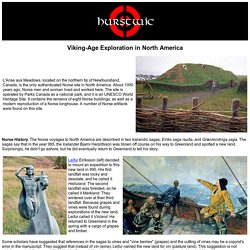
The Norse voyages to North America are described in two Icelandic sagas, Eiríks saga rauða, and Grænlendinga saga. The sagas say that in the year 985, the Icelander Bjarni Herjólfsson was blown off course on his way to Greenland and spotted a new land. Vikings: Viking Exploration (video) History, Exploration, Facts, & Maps (article) Viking, also called Norseman or Northman, member of the Scandinavian seafaring warriors who raided and colonized wide areas of Europe from the 9th to the 11th century and whose disruptive influence profoundly affected European history. These pagan Danish, Norwegian, and Swedish warriors were probably prompted to undertake their raids by a combination of factors ranging from overpopulation at home to the relative helplessness of victims abroad. Top Questions. How Vikings navigated the world.
During the Viking Age, people started to categorise ships according to their functions. There were two types. One was primarily suitable for transporting armed men. The other was suitable for transporting cargo. Pictured here is the Viking Ship Museum’s freighter Ottar, which is of the type that was used for navigating the North Atlantic islands. (Photo: the Viking Ship Museum in Roskilde). Vikings: raiding and trading in the Middle Ages.
What, today, we call ‘Vikings’ should more properly be called ‘Scandinavians of the 9th, 10th and early 11th centuries’, because ‘vikings’ means ‘pirates’. When we talk about Vikings today, we mean not only pirates, but also women, children, and elderly people, not just the people who went on the Viking raids. The feminine noun ‘viking’ means an ‘armed raid’ or ‘army expedition’. So a viking is a pirate or a robber. Today by the term “Viking” we mean every Scandinavian who lived during those two and a half or three centuries in the early Middle Ages. The transition to Christianity. In 826 Harald Klak consented to be baptised and thus became the first Danish Christian Viking king. Apparently he did not agree to this out of a strong commitment to Christianity.
At this point in time Harald was in exile, after having been granted refuge by the Frankish king Louis the Pious (814-840). This exile had resulted from various disputes over the royal rule of Denmark, which arose in the wake of King Godfrey’s death in 810. Subsequently Harald became king, together with his brother in 812-13, and with Godfrey’s sons in the period 819-27. However, dividing up the land with Godfrey’s sons was not without its conflicts. History - Ancient History in depth: Viking Religion. Norse Social Structure. The ancient Vikings Social structure was relatively simple, and followed many of the common traits all societies exhibit.
Of course in every society there are the high status members and the lower status members, Viking society was no different at all. Being a member of upper echelon of Viking society obviously offered plenty of rewards and benefits, and was held by the Viking Kings. At the lower end of Viking society was the Thralls, the slaves of the Viking world.
In the middle we had the Viking people, separated into two main classes the Karls and the Jarls. As we learn more about the details and intricacies of the Viking social structure we will learn more about the main classes that existed here. Viking Ships. The truth about Vikings: Not the smelly barbarians of legend but silk-clad, blinged-up culture vultures. Courtship, Love and Marriage in Viking Scandinavia. Primary History - Vikings - Trade and exploration. Plot Summary. BEOWULF - SUMMARY, THEME, CHARACTERS & SETTING. Viking Myths you thought were true! Ten Minute English and British History #05 -The Vikings and the Danelaw. Viking Raid on Lindisfarne (AD793) History: Vikings. Vikings - KS2 History - BBC Bitesize. Vikings sheets DNL.
History of the Vikings (in One Take) History Bombs. BBC Learning Who were the Vikings on Vimeo. Horrible Histories Viking song, Literally. We are the Vikings (history teachers) Norse Legends [Audio] The story of Ragnarok and the Apocalypse. World of Mythology. Thurisaz. Unearthing the 1,000-Year-Old Story of a Rare Viking Toolbox. Youtube. Myths and legends from Switzerland. (2) Berserkers (Berserkir) and Úlfhéðnar. (5) Lord of the Noose: Odin and the Dead.
Viking Berserkers: Force for Evil or Sacred Warriors? (5) The Children of Ash: Cosmology and the Viking Universe. (6) NORSE MYTHOLOGY STORIES. Norse Statuary? Viking Shield - Replicas And Gifts.